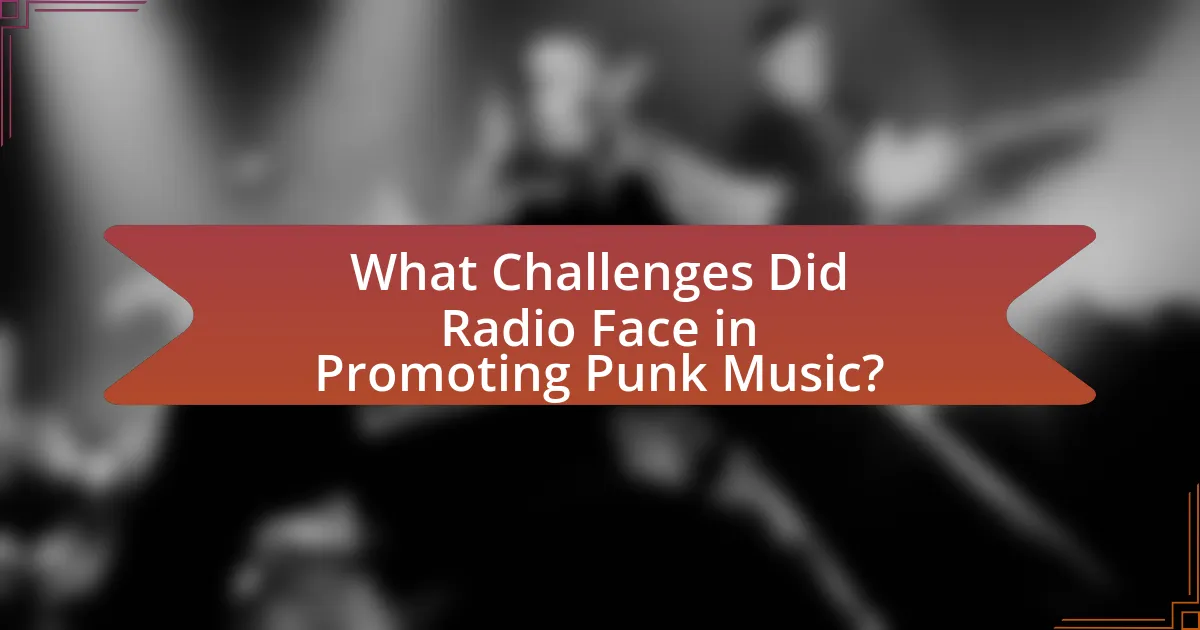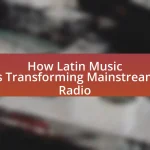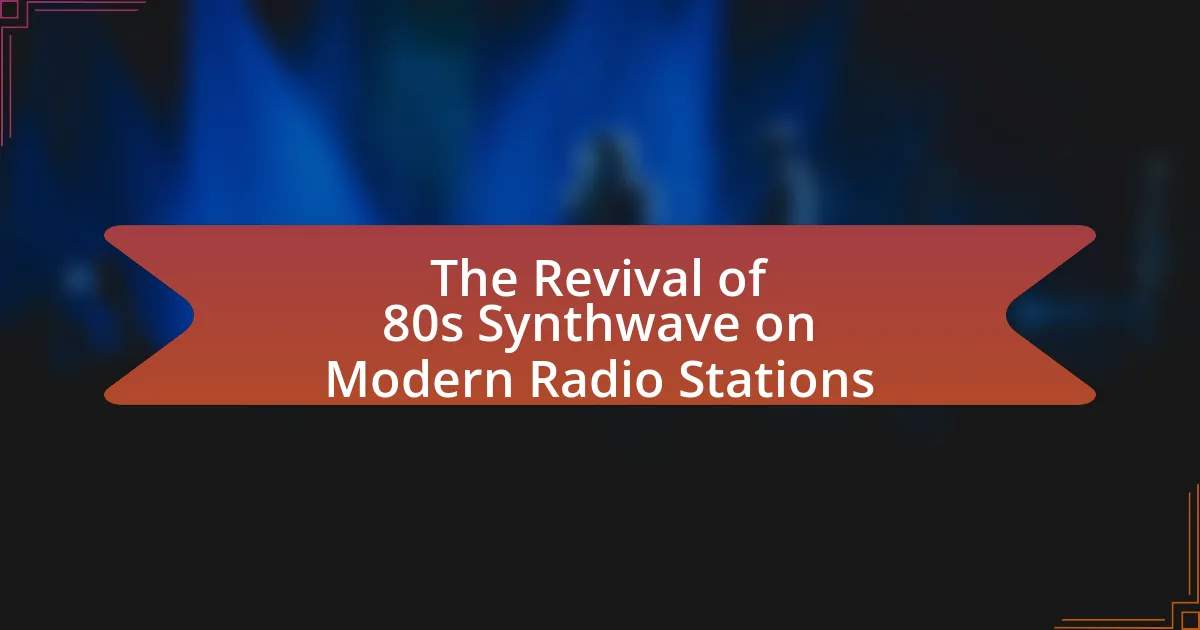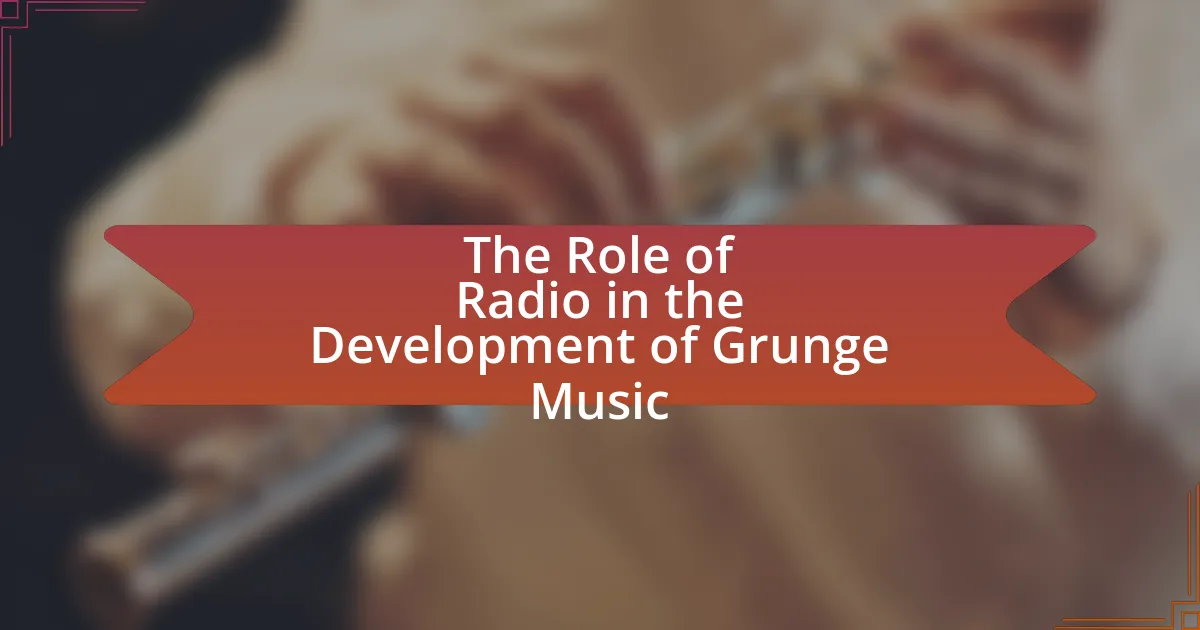The article analyzes the pivotal role of radio in the punk music movement, highlighting how it provided a platform for underground bands to reach broader audiences during the late 1970s and early 1980s. Key radio stations, such as WLIR, KROQ, and WFMU, played significant roles in promoting punk music, fostering community engagement, and disseminating the genre’s cultural and political messages. The article also discusses the challenges punk bands faced in gaining airplay on mainstream radio, the impact of censorship, and the strategies they employed to overcome these barriers, including the support from independent and pirate radio stations. Additionally, it outlines best practices for promoting punk music on radio today, emphasizing the importance of community and diversity in playlists.

What is the Role of Radio in the Punk Music Movement?
Radio played a crucial role in the punk music movement by providing a platform for underground bands to reach wider audiences. During the late 1970s and early 1980s, many punk bands, such as The Ramones and Sex Pistols, gained exposure through college radio stations and independent broadcasts that prioritized alternative music over mainstream commercial hits. This access allowed punk music to flourish outside traditional music industry channels, fostering a DIY ethos that characterized the movement. Additionally, radio shows dedicated to punk music, like “Punk’s Not Dead” on WFMU, helped to cultivate a community around the genre, promoting not only music but also the associated cultural and political messages.
How did radio influence the emergence of punk music?
Radio significantly influenced the emergence of punk music by providing a platform for underground bands to reach wider audiences. In the 1970s, radio stations began to embrace alternative formats, allowing punk bands like the Ramones and Sex Pistols to gain exposure through airplay. This exposure was crucial as it helped to cultivate a community around punk music, encouraging fans to attend live shows and purchase records. Additionally, radio’s ability to disseminate new sounds quickly contributed to the genre’s rapid growth and acceptance, as stations like WLIR in New York played a pivotal role in promoting punk and new wave music, thus validating its place in the music scene.
What were the key radio stations that supported punk music?
Key radio stations that supported punk music include WLIR in New York, KROQ in Los Angeles, and WFMU in New Jersey. WLIR was instrumental in promoting punk bands like The Ramones and Blondie during the late 1970s, providing a platform for their music that was often ignored by mainstream outlets. KROQ played a significant role in the early 1980s by featuring punk and new wave artists, helping to popularize the genre on the West Coast. WFMU, known for its eclectic programming, showcased underground punk acts and contributed to the genre’s visibility in the New Jersey and New York areas. These stations were crucial in shaping the punk music landscape by offering airplay to artists who challenged the mainstream music scene.
How did radio broadcasts shape the punk music scene?
Radio broadcasts significantly shaped the punk music scene by providing a platform for underground bands to reach wider audiences. In the late 1970s, stations like WLIR in New York and KROQ in Los Angeles played a crucial role in promoting punk music, often featuring tracks from bands that were not signed to major labels. This exposure helped to cultivate a dedicated fan base and fostered a sense of community among punk enthusiasts. Additionally, radio shows dedicated to punk music, such as “Punk’s Not Dead,” introduced listeners to new sounds and ideologies, further solidifying punk’s cultural impact. The ability of radio to disseminate music quickly and broadly was instrumental in the genre’s growth and acceptance within mainstream culture.
Why is radio considered a vital medium for punk music?
Radio is considered a vital medium for punk music because it provided an accessible platform for underground artists to reach a wider audience. During the late 1970s and early 1980s, when punk was emerging, traditional music industry channels often overlooked or rejected punk bands. Radio stations, particularly college and independent stations, played a crucial role in broadcasting punk music, allowing bands like The Ramones and Sex Pistols to gain exposure. This grassroots approach facilitated the spread of punk culture and ideology, fostering a sense of community among fans and artists. The ability of radio to bypass mainstream commercial barriers made it essential for the punk movement’s growth and sustainability.
What unique features of radio made it suitable for punk music promotion?
Radio’s unique features, such as its accessibility, immediacy, and ability to reach diverse audiences, made it particularly suitable for punk music promotion. The medium allowed for the rapid dissemination of punk music and culture, enabling underground bands to gain exposure without the need for traditional record label support. Additionally, radio’s capacity for live broadcasts and interviews provided a platform for punk artists to connect directly with listeners, fostering a sense of community and engagement. The DIY ethos of punk aligned well with the independent nature of many radio stations, particularly college and community stations, which often embraced alternative music genres and provided a space for punk to thrive.
How did radio help in the distribution of punk music?
Radio significantly aided in the distribution of punk music by providing a platform for underground bands to reach wider audiences. In the late 1970s, many punk bands, often lacking major label support, utilized college and independent radio stations to broadcast their music, which was crucial for gaining exposure. For instance, stations like KROQ in Los Angeles and WLIR in New York played pivotal roles in promoting punk tracks, helping to establish a fan base and create a sense of community around the genre. This grassroots approach allowed punk music to flourish outside mainstream channels, leading to its eventual acceptance and influence in popular culture.

How did Radio Shape Punk Music Culture?
Radio significantly shaped punk music culture by providing a platform for underground bands to reach wider audiences. In the late 1970s, stations like WLIR in New York and KROQ in Los Angeles began to play punk music, which was often ignored by mainstream media. This exposure allowed punk bands such as The Ramones and The Sex Pistols to gain popularity and influence, fostering a sense of community among fans. Additionally, radio shows dedicated to punk music, like “Punk Show” on KXLU, created a space for discussion and promotion of the genre, further solidifying its cultural impact. The ability of radio to disseminate music quickly and broadly was crucial in establishing punk as a significant movement in the music industry.
What role did radio play in connecting punk communities?
Radio served as a crucial medium for connecting punk communities by broadcasting underground music and promoting local bands. This facilitated the dissemination of punk culture across geographical boundaries, allowing fans to discover new music and connect with like-minded individuals. For instance, shows like “Punk’s Not Dead” on stations such as WFMU in New Jersey played a significant role in introducing listeners to emerging punk artists and fostering a sense of community among fans. Additionally, radio provided a platform for punk ideologies and messages, amplifying the voices of marginalized groups within the scene.
How did local radio shows contribute to the punk subculture?
Local radio shows significantly contributed to the punk subculture by providing a platform for underground bands and fostering community engagement. These shows often featured punk music that mainstream media overlooked, allowing listeners to discover new artists and sounds that defined the movement. For instance, stations like KROQ in Los Angeles and WLIR in New York played pivotal roles in promoting punk bands such as The Ramones and The Sex Pistols, which helped to shape the genre’s identity. Additionally, local radio hosts often engaged with their audiences through live events and discussions, creating a sense of belonging and activism within the punk community. This grassroots approach to music dissemination was crucial in establishing punk as a cultural force during the late 1970s and early 1980s.
What impact did radio have on the identity of punk music fans?
Radio significantly shaped the identity of punk music fans by providing a platform for the genre’s underground sounds to reach a wider audience. This exposure allowed fans to connect with the rebellious ethos of punk, fostering a sense of community and shared identity among listeners. For instance, radio stations like WLIR in New York played a crucial role in promoting punk bands such as The Ramones and Blondie, which helped solidify the genre’s presence in mainstream culture. Additionally, the DIY spirit of punk was echoed in radio’s grassroots approach, where local stations often featured independent artists, reinforcing the values of authenticity and anti-establishment sentiments that punk fans embraced.
How did radio facilitate the spread of punk ideology?
Radio facilitated the spread of punk ideology by providing a platform for underground bands to reach wider audiences, thereby amplifying their messages of rebellion and anti-establishment sentiments. In the late 1970s, stations like WLIR in New York and KROQ in Los Angeles began to play punk music, which was often ignored by mainstream media. This exposure allowed punk bands such as The Ramones and The Sex Pistols to gain traction, influencing youth culture and promoting the DIY ethos central to punk ideology. The accessibility of radio broadcasts enabled listeners to discover and connect with punk music and its associated values, fostering a sense of community among fans and encouraging the proliferation of punk scenes across various cities.
What messages were conveyed through punk music on the radio?
Punk music conveyed messages of rebellion, anti-establishment sentiments, and social critique on the radio. This genre often challenged mainstream norms and addressed issues such as political corruption, economic inequality, and personal freedom. For instance, songs like “Anarchy in the U.K.” by the Sex Pistols explicitly criticized the British government and societal structures, reflecting the disillusionment of youth during the 1970s. Additionally, punk music promoted individuality and self-expression, encouraging listeners to question authority and embrace their identities. The raw sound and direct lyrics resonated with audiences, making punk a powerful medium for social commentary during its rise on radio platforms.
How did radio help in the promotion of punk bands and their messages?
Radio played a crucial role in promoting punk bands and their messages by providing a platform for their music to reach a wider audience. During the late 1970s and early 1980s, many punk bands, often marginalized by mainstream media, found support through college radio stations and independent broadcasters that embraced alternative music. These stations frequently aired punk tracks, allowing bands like The Ramones and Sex Pistols to gain exposure and connect with fans who resonated with their anti-establishment themes. Additionally, radio interviews and live performances helped convey the punk ethos, fostering a sense of community among listeners and encouraging the DIY culture that defined the movement. This grassroots approach to radio broadcasting significantly contributed to the punk genre’s growth and its messages of rebellion and individuality.

What Challenges Did Radio Face in Promoting Punk Music?
Radio faced significant challenges in promoting punk music due to its rebellious nature and anti-establishment ethos. The mainstream radio industry, which prioritized commercial viability and mass appeal, often viewed punk music as too abrasive and controversial for its audience. This perception led to limited airplay for punk bands, as radio stations were hesitant to feature music that challenged societal norms and traditional musical structures. Additionally, the DIY (do-it-yourself) approach of many punk artists, who often self-produced their music and operated outside of major record labels, made it difficult for radio to access and promote their work effectively. The cultural clash between punk’s underground roots and radio’s commercial interests created a barrier that hindered the genre’s exposure on mainstream platforms.
Why was punk music often marginalized by mainstream radio?
Punk music was often marginalized by mainstream radio due to its anti-establishment ethos and raw sound, which contrasted sharply with the polished production and commercial appeal favored by mainstream broadcasters. This genre emerged in the 1970s as a reaction against the prevailing music industry norms, promoting a do-it-yourself attitude that rejected corporate influence. Additionally, the lyrical content of punk often addressed controversial social and political issues, making it less palatable for mainstream audiences and advertisers. As a result, radio stations, which relied on advertising revenue and audience ratings, tended to avoid punk music in favor of more commercially viable genres.
What were the barriers punk bands faced in getting airplay?
Punk bands faced significant barriers in getting airplay primarily due to radio station policies that favored mainstream music. These policies often excluded punk music, which was characterized by its rebellious nature and anti-establishment themes. Additionally, many radio stations were owned by large corporations that prioritized commercial viability over diverse music genres, leading to limited exposure for punk bands. For instance, during the late 1970s and early 1980s, major radio networks largely ignored punk in favor of more commercially successful genres like disco and rock, which further marginalized punk music from mainstream airwaves.
How did censorship affect punk music on the radio?
Censorship significantly limited the exposure of punk music on the radio by restricting the broadcast of songs with explicit lyrics or controversial themes. This restriction led to many punk bands either altering their lyrics to fit radio standards or facing reduced airplay, which hindered their ability to reach wider audiences. For instance, songs like “God Save the Queen” by the Sex Pistols faced bans due to their provocative content, illustrating how censorship directly impacted the promotion and acceptance of punk music within mainstream media. Consequently, the censorship environment forced punk artists to seek alternative platforms, such as independent radio stations and underground venues, to share their music and messages.
What strategies did punk bands use to overcome radio challenges?
Punk bands overcame radio challenges primarily by utilizing independent labels and grassroots promotion. Independent labels like SST Records and Dischord Records provided a platform for punk bands to release their music without the constraints of mainstream radio. These labels often focused on regional distribution and built strong local followings, which helped bypass traditional radio gatekeepers. Additionally, punk bands engaged in live performances, fanzines, and word-of-mouth marketing to cultivate their audience, effectively creating a community that supported their music outside of mainstream radio channels. This approach was crucial during the late 1970s and early 1980s when punk music faced significant resistance from commercial radio stations that favored more mainstream genres.
How did independent radio stations support punk music?
Independent radio stations supported punk music by providing a platform for underground bands to reach audiences that mainstream media overlooked. These stations often featured punk music in their playlists, allowing artists like The Ramones and Sex Pistols to gain exposure. For instance, in the late 1970s, stations such as WFMU in New Jersey and KROQ in Los Angeles played a crucial role in promoting punk tracks, which were often banned or ignored by commercial radio. This grassroots support helped cultivate a dedicated fan base and fostered the punk community, enabling the genre to thrive despite limited commercial viability.
What role did pirate radio play in the punk movement?
Pirate radio played a crucial role in the punk movement by providing an alternative platform for the dissemination of punk music and culture, bypassing mainstream media censorship. During the late 1970s, traditional radio stations often ignored or marginalized punk bands, leading to the rise of unlicensed broadcasts that embraced the genre’s rebellious spirit. These pirate stations, such as Radio Caroline in the UK, allowed punk artists to reach audiences directly, fostering a sense of community and promoting underground music that challenged societal norms. The impact of pirate radio was significant, as it not only facilitated the spread of punk music but also empowered listeners to engage with a countercultural movement that rejected commercialism and embraced DIY ethics.
What are the best practices for promoting punk music on radio today?
The best practices for promoting punk music on radio today include leveraging social media for audience engagement, collaborating with local punk bands for live sessions, and curating playlists that reflect the genre’s diversity. Social media platforms allow radio stations to connect with listeners, share upcoming shows, and promote new releases, enhancing visibility. Collaborating with local punk bands for live sessions not only showcases emerging talent but also fosters community support, which is vital in the punk scene. Additionally, curating diverse playlists that include both classic and contemporary punk tracks can attract a broader audience, as it highlights the genre’s evolution and relevance. These strategies are effective in maintaining listener interest and promoting punk music in a competitive radio landscape.






